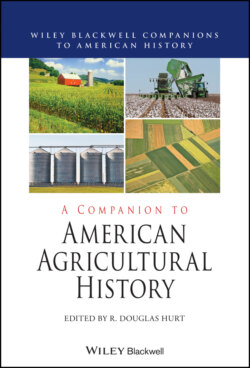Читать книгу A Companion to American Agricultural History - Группа авторов - Страница 29
The South
ОглавлениеThe most impressive feature of American agriculture 1790–1830 was the cotton boom. The British invented textile manufacturing machinery for which cotton was the best fiber, and then British and finally world demand for cotton soared (Beckert 2015). The United States became by 1820 the prime supplier of the fiber to England and then the world. Eli Whitney’s cotton gin in 1793 enabled widespread cultivation of the plant by mechanically removing the seeds from the boll of green seed cotton, the plant variety that grew exuberantly in mainland southern soil. Cotton raised in the United States in 1790 was merely 3,000 bales; by 1830, it was 732,000 bales (a bale weighed 400 pounds; US Bureau of the Census 1975). Because of world demand, cotton became by far the most valuable American export.
Of all American agriculture in this period, cotton cultivation showed the most impressive dynamism in experimentation and change. This experimentation involved the search for a seed that would allow quicker harvesting. The early seed was a variety such that a field hand might be able to pick 50–60 pounds per day. Planters experimented by cross-breeding with Mexican cotton seeds and produced the Rodney seed; with the Rodney seed, field hands might collect 200–300 pounds of cotton per day (Moore 1988).
This productivity advance was matched by alterations in plantation management—an ignominious story. Planters needed great numbers of laborers; this meant slaves of African descent, which they obtained from the domestic slave trade, from migrating planters, and from those escaping the Saint-Domingue Revolution of the 1790s (Berlin 1998; Deyle 2005). Cotton planters managed these slaves by the “gang” system using white overseers. Compared to tobacco, cotton work routines in the Deep South were more strict and disciplined, and the use of the whip more frequent. By the 1830s, the use of slaves in a regimented manner to generate high output of cotton on the plantations was in place (Fogel and Engerman 1989; Berlin 1998). Planters also raised much corn for slaves and animals, and practiced a form of the long fallow to preserve soil fertility (Moore 1988; Majewski 2009).
Sugar and rice plantations were the other large-scale agricultural undertakings of the slave South. Knowledge of sugar cultivation and production came to Louisiana from French sources, especially after the Saint-Domingue Revolution. Sugar production required much capital and skilled labor. The basics of Louisiana sugar arrived after 1795, including a better cane (ribbon cane in 1817) and the Jean Etienne de Boré innovation of turning the cane juice into granulated sugar (Joe Taylor 1963; Rodrigue 2001). Rice planters experimented. They increased the crop yield, improved drainage and sluices, and used machines to separate the seed from the husk (Coclanis 1989; Chaplain 1993). Both sugar and rice production were known as miserable occupations for slaves because of heat, humidity, and tropical diseases. Rice cultivation, though using the task system, was probably the worst as the cultivators had to wade through mud and stagnant pools to make cultivation possible (Berlin 1998; Morgan 1998).
The border or upper slave states had a different trajectory than the states devoted to cotton. They had economies mutating away from plantation slavery (though plantations there certainly existed) and they were slowly adapting to mixed-crop agriculture. While the cotton boom states had slave populations that constituted nearly 45–50 percent of the total population, the Upper South states had slave populations of between 15 and 30 percent. The Upper South states had more of a yeoman farmer character than the plantation states, but they lacked the prosperity of the cotton belt. The most interesting states were Maryland and Virginia. The foreign market for tobacco had disappeared, and so planters turned to wheat. In western Maryland and the Shenandoah Valley, wheat became the new staple of prosperity. But in the Tidewater and parts of the Piedmont, the embrace of wheat brought disaster between 1790 and 1820 because the planters exhausted the soil (Walsh 1993; Berlin 1998).
A persistent puzzle about the antebellum South is the condition of the average, nonslaveholding white farmer. It is likely that a considerable yeoman farming culture existed in the years 1790 to 1830 in which farmers probably owned their own land and existed in kinship neighborhoods. Most yeomen lived on land of marginal fertility, the “pine barrens” and elevated areas where cotton and tobacco could not grow. These farmers probably had an adequate standard of living, but they were by no means prosperous (Bolton 2005; Hyde 2005).
